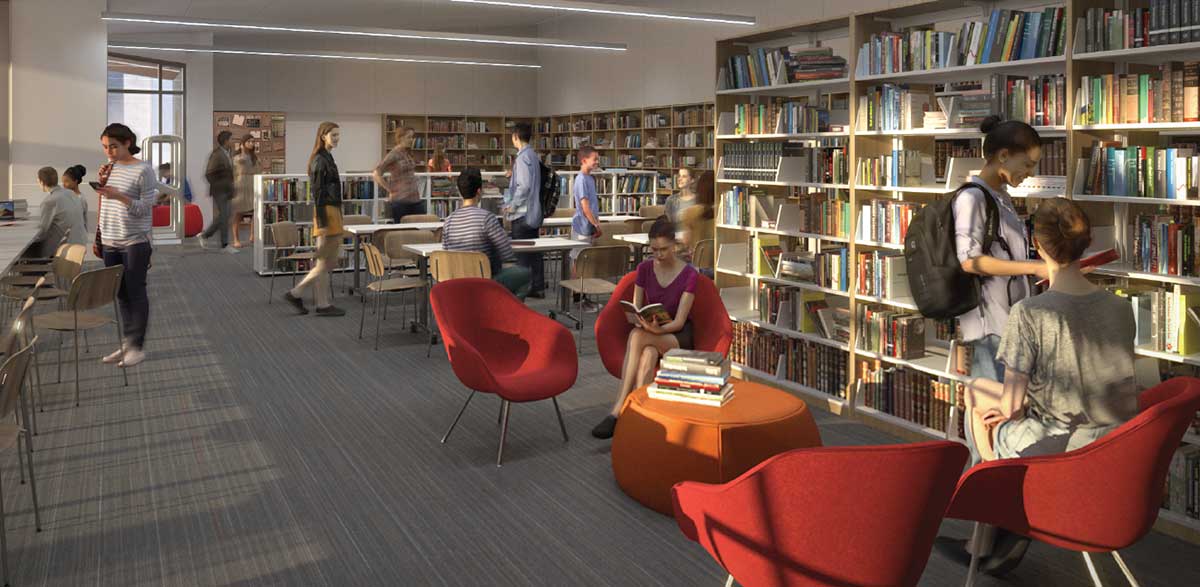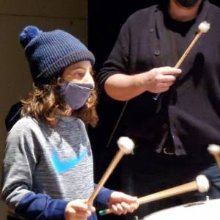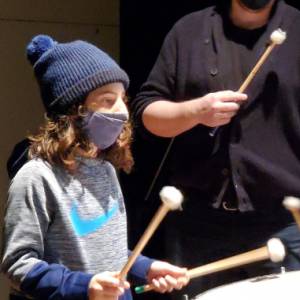371 Bloor Street West
Toronto, ON M5S 2R7 get directions
Toronto, ON M5S 2R7 get directions


The sounds of the UTS Senior Winds Ensemble warming up their flutes, clarinets, horns and more filled the school gym at 30 Humbert. UTS Director of Music Mark Laidman had secured the space so the Ensemble could gather together in early December for the first time in 22 months, and now he had no idea what was going to happen.
Student musicians sat spaced two metres apart, taking up half the gym, all wearing instrument masks with a hole for playing, as well as bell covers to prevent air escaping from the instruments. They had been practicing The Mandalorian, the theme from the Star Wars television series, alone in their homes and now it was time for the moment of truth. Mark raised the baton.
“When I heard the first downbeat, it was a pretty awesome moment for me,” says Mark. “I put a lot of trust in the students practicing and I got to hear what they had been doing at home for the first time in a long, long time. It was a really great rehearsal. That's what we’ve been missing as music teachers and as band leaders – hearing that sound of all those musicians playing in front of you.”
Moments like these become all the more extraordinary considering the behind-the-scenes adaption and planning required to make them happen. The COVID-19 pandemic changes how we play, but COVID can’t stop the music.
"The support from the school community and administration and the incredible adaptability of our students has helped us shift how we do things to keep thriving,” says Sarah Shugarman, UTS Music teacher and Coordinator of the Expressive Arts department.
In the fall, UTS invested in masks specifically designed for both wind players and their instruments, so students wear a mask with a little slit to play and have a mask fitted onto the bell of the instrument to slow the spread of aerosols. Extra HEPA filters were also added to the music rooms. Because students could no longer share instruments due to the coronavirus, the school arranged to rent enough instruments, so each student could have their own. For the 2020-21 school year, UTS made a major pivot to continue offering a high-quality instrumental program – new F1 (Grade 7) students who planned to play a wind instrument were given the opportunity to learn a string instrument instead, as a safer option for the pandemic.
UTS enhanced the Music department with two part-time Associate Teachers, Matteo Ferrero-Wong, an orchestral strings teacher specializing in double bass and clarinet, and Dr. Jeff McLeod, music teacher and professional musician, whose band, the Donnybrook Organ trio, has infused UTS music classes with the rhythms of modern and soul jazz. With Sarah, Mark and Music teacher Lyris Pat, that makes five teachers, but because it was necessary to have fewer students sharing space during the pandemic, the music program has brought in several instrumental specialists to create smaller groups for safer playing. Clinicians were also hired as virtual music guests in lockdown, which included UTS alumni violinists Aaron Schwebel ’06, concertmaster at the National Ballet of Canada Orchestra; Dr. Conrad Chow ’99, who teaches at University of Toronto and Royal Conservatory of Music; and Emma Meinrenken ’17, as well as flutist Rebecca Moranis ’16 and retired UTS music teacher Ron Royer.
At the outset of the pandemic, the sudden lockdown left many students without their instruments, but not for long! UTS teachers drove over 300 kilometres, all the way from Guelph to Scarborough to Newmarket and more, delivering 40 instruments to UTS students so they could keep practicing music.
Throughout the pandemic, music learning adapted with physical distancing, digital tools, cross-border virtual guests and online collaborations. When the pandemic first began, this resilience shone through in a moving first virtual performance in April 2020: A Million Dreams, by the UTS Chamber Strings featuring singer Lucas D'Iorio Fournier ’20, an S6 (Grade 12) student at the time. Already rehearsed and ready to go, the piece had been the finale of Nocturne, the annual UTS music recital, in February 2020, which turned out to be the school’s last live, in-person concert before the pandemic. For the online performance, students contributed their recordings from home and the edited video was shared as the grand finale of the UTS Beyond Success celebration for the Building the Future campaign, which raised over $60 million for the school’s renewed building at 371 Bloor Street.
As school transitioned to online, then hybrid and back again, UTS Music teachers and students embraced cloud-based, collaborative digital music composition, music notation and production software like Soundtrap, as well as Reaper digital audio workstation. For example, F1 (Grade 7) students used Flat software to collaborate on writing four-part compositions, using motivic material based on the rhythms of their names, an assignment that arose out of the restrictions of the pandemic. Students have also learned to create multi-tracked video performances of themselves performing to their own accompaniment. “It’s kind of like creating their own little band or even their own little musical world in their homes,” says Mark.
Apps such as SmartMusic helped support performance and instrumental study, and students experimented with synchronous performance apps that can allow musicians to play together live and in sync.
Music teacher Matteo Ferrero-Wong adapted the F1 (Grade 7) body percussion program for hybrid school, by finding a way to bring in two hybrid students playing from home, and recording this video. Students learned four body percussion patterns and then rearranged them to create big group and small group sections both with different patterns and choreography.
After the event, the Heavyweights Brass Band joined the parade for the House Track event at Lamport Stadium.
In fall 2021, the nearby Trinity Bellwoods Park and the park behind our school at 30 Humbert became our unofficial music classrooms. Mark and the other Music teachers took their classes outside so students could play together, with students carrying the instruments over to the park. One fall day, M4 (Grade 10) and S5 (Grade 11) music classes in both parks were joined by the Heavyweights Brass Band for clinics on New Orleans Jazz.
Before the onset of omicron, UTS hosted a special, all-day Winds Weekend Workshop at 30 Humbert in November to give F2 and M3 (Grade 8 and 9) students a chance for masterclasses on saxophone, clarinet, bassoon, flute, trombone and trumpet, as well as percussion, to make up for the in-person learning time they lost since spring 2020.
“Students have been incredibly patient and resilient in this time where wind playing has been very difficult,” says Matteo, one of the Music teachers running the event. “They were so happy to be playing their instruments safely and under the leadership of some of Toronto’s finest musicians.The faculty concert was a real highlight – live performances are so rare during the pandemic. The students were on the edge of the seats the entire time, taking in every second of the music.”
Another highlight of the day: the Junior Winds Ensemble had the opportunity to play together for the first time since before the pandemic.
A similar effort made use of the gym and classrooms at 371 Bloor Street West for F1 (Grade 7) music students, to introduce them to their instruments.
As the world grew smaller with virtual connections, UTS music classes came to life with cross-border collaborations and inspiring guests from Vancouver to Madrid presenting on topics such as music therapy, music and cognition, electroacoustics, songwriting, classical Arabic and Indian music traditions and more. Virtual visitors included the likes of renowned violinist and Adrian Anantawan in Boston, Metis composer and University of Toronto professor Eliot Britton, musician and producer Justin Gray and more.
“Musical experiences for our students are no longer limited by time and space,” says Sarah Shugarman. “Some of these amazing collaborations would not have happened if we weren't forced into this very challenging chapter which inspired so many new opportunities.”
Just this month, F2 (grade 8) student Jibril’s class enjoyed a virtual visit from Gemini-nominated film and television composer Tom Third. “It was really interesting and intriguing hearing about his musical journey and how he started off doing rap and hiphop and then transitioned slowly into film music,” says Jibril.
Last year, Jibril performed Nocturne Opus 20 No. 9 by Frédéric Chopin as a virtual thank you to UTS donors.
Jibril, an accomplished pianist who also joined the Junior Strings Ensemble this school year, says he loves how rich the string instruments sound when they all come together. “The good thing is the pieces were really hard, but for people like me who don’t have a lot of strings experience, the others helped tutor us, and I think that's where I learned the most.”
Jibril worked one-on-one with S6 (Grade 12) Victoria last school year and S6 (Grade 12) Adam in 2021-22. Sarah credits senior students as instrumental to the success of the F1 (Grade 7) strings program in hybrid school last year, volunteering to give younger students additional instruction.
The pandemic enabled virtual partnerships to thrive during lockdown. This year, UTS is taking part in the Future is Now Project and Festival in partnership with the San Francisco-based Kronos Quartet and several U.S. schools. This collaborative virtual gathering will share music from 50 for the Future: The Kronos Learning Repertoire, a catalogue of newly commissioned works representing diverse music from across the globe.
This year we have also been working with the Boston-based Milton Academy on two new commissions as part of an exciting project that promotes collaboration and new work for high school level ensembles by diverse living composers,
says Sarah.
The new works, one composed by Layth Sidiq, Artistic Director of the New York Arabic Music Ensemble (who has also been a virtual guest in UTS classes), and another by UTS alum Shreya Jha ’16, will be premiered by both schools in the spring.
Last spring, a collaboration between Milton Academy and UTS debuted a chamber string ensemble rendition of one of Kronos Quartet’s 50 for the Future pieces, Marejada. By Puerto Rican composer, performer and educator Angélica Negrón, the piece was composed to be performed synchronously on Zoom by musicians playing from home using the discrepancies in latency sound quality as a tool.
For S6 (Grade 12) student Isabella, leader of UTS Chamber Strings and Senior Strings ensembles, learning Marejada in lockdown gave her the chance and the time to engage with contemporary work. “I have been playing violin since I was three years old, but never really played much modern music and it was great to learn it with all of the time we were spending at home.”
Isabella also looks back with joy at UTS Chamber Strings’ performance of Samuel Barber's Adagio for Strings for Remembrance Day 2020 at 371 Bloor in the Music Room, another rare chance in the pandemic where they were able to perform together. “It was a really, really beautiful piece and the first time that I had been able to play with other people since the beginning of the pandemic. Playing together in person feels very transformative now.”
UTS Chamber Strings’ performance of Samuel Barber's Adagio for Strings for Remembrance Day 2020.
These are the kind of moments UTS Music teachers live for too, and despite the symphony of challenges COVID-19 presents for music in the pandemic, Mark feels positive about all we’ve managed to accomplish together. “I’m so happy we still have students in our music classrooms, engaging with music, and we’ve been able to continue doing what we all love to do,” he says. “It might look different than what we've been used to, but I feel so fortunate that we could pivot and do some awesome music-making over the last two years.”
